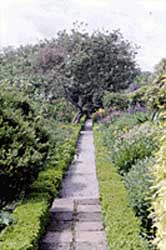Buxus
 Buxus (Box)
Buxus (Box)
Family Buxaceae
Between 30 and 70 species (depending on authority).
Buxus are frequently pruned as hedges (see photo), topiaries, or just to control their shape.
Good tub plant.
Can also be grown amongst other shrubs for foliage affects.
They are evergreen shrubs and occasionally small trees. Leaves entire, thick or leathery, stiff & arranged opposite.
Buxus grow in most ordinary soils, in the open or in shade. They are very slow growing, but can live for hundreds of years, very hardy, and tolerates most soils and a wide range of climates – they will survive extreme cold.
For optimum colour and vigour, you need to water in dry periods, and fertilise annually.
Plants respond to mulching.
Pruning is not essential for health.
Propagate by cuttings.
Usually does not suffer from many pests or diseases; however the following have occasionally been recorded: Canker, Blight, Leaf Spot, Root Rot, mealy bug, scale, psyllid, leaf miner, web worm.
Cultivars
B. balerica -to 2m tall, dark green leaves not as glossy as B. sempervirens.
B. microphylla -has smaller leaves, some cultivars are prostrate; others small shrubs to 90cm tall; hardier than B. sempervirens. Many named cultivars are grown, some with different foliage affects, some being extra frost hardy.
B. sempervirens -many forms are available, some can grow to as tall as 4m; though most cultivars are closer to 1m tall. Foliage is dense, dark green and very glossy. This is the most commonly cultivated species. Forms vary in colour texture of foliage; and in height and shape; some are variegated.